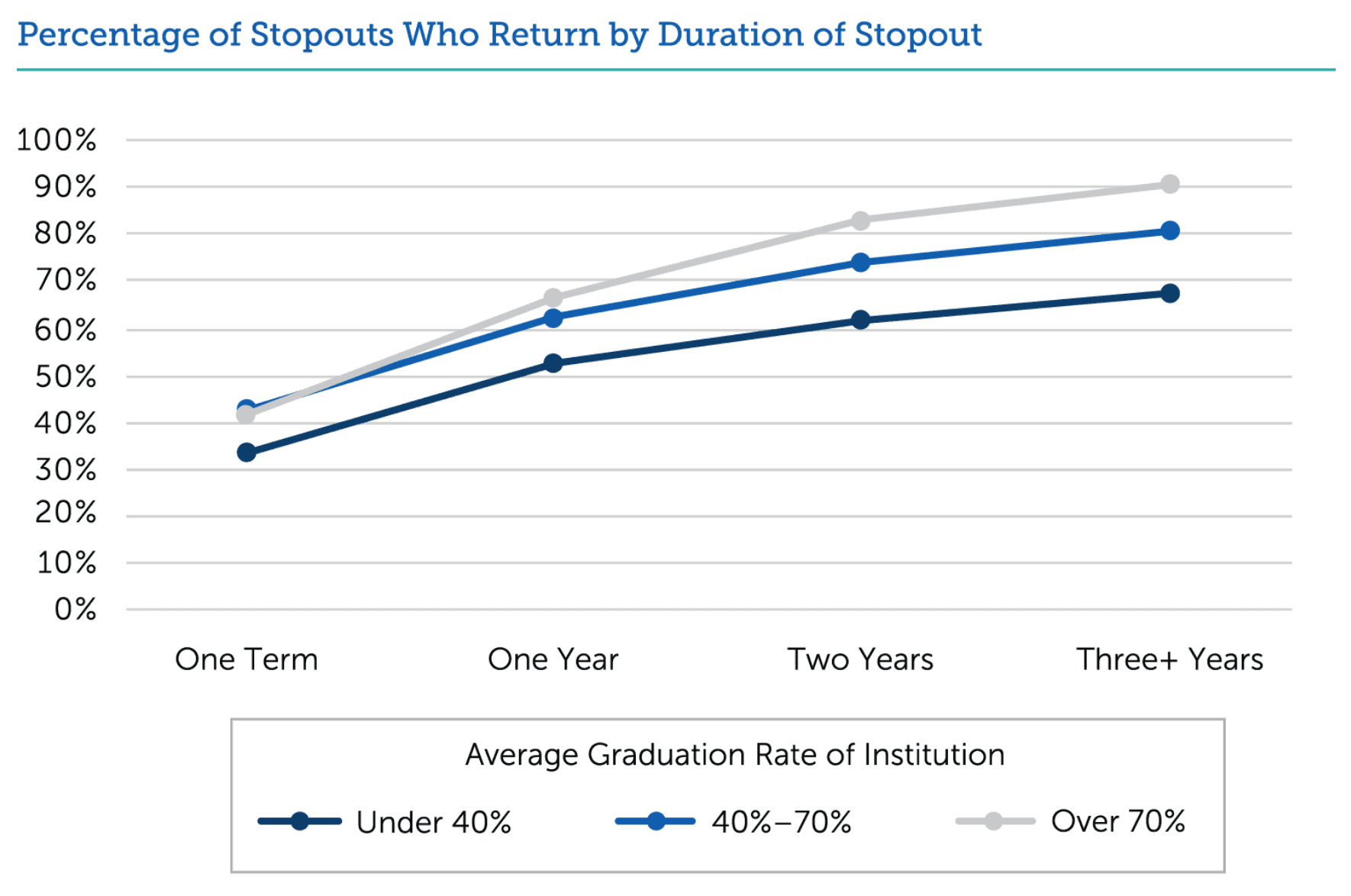-
What is a stopout?
A stopout is someone who withdraws from enrollment at a college or university for a period of time.
This definition implies that a stopout is a dropout who intends to go back to college. Since we rarely know students’ intentions and want to re-recruit these students, and since this white paper is about re-recruiting these students, this report makes the assumption that all dropouts are potentially stopouts and uses the term accordingly.
At the end of any given term, all institutions have stopouts. There are always students who attended during the previous term but are now unaccounted for. They didn’t graduate, and they didn’t re-enroll. But little is known about what happens to these unaccounted-for students.
Data from more than 150 of EAB’s student success partners shows that many students return to school after short absences, either on their own initiative or in response to re-enrollment outreach from their institution. We wanted to know at what point in time standard re-enrollment efforts begin to lose efficacy and necessitate additional outreach and support.
We conducted our review by following a given cohort of students to see what percentage would return in an upcoming term. In other words, if we looked at students who attended in fall 2018, what percentage was accounted for (attended or graduated) in spring 2019, fall 2019, etc. This review would identify students who maintained steady enrollment and those who stopped out but returned in a future term. We then categorized the data by institutional graduation rate in order to find different trends across institution types.
Download the Full Insight Paper
Who returns?
The graph below summarizes our findings. Following students from any given term, you can see how many of them stop out for one term and then return the next term as compared to those who are gone for longer periods. For example, at colleges with graduation rates above 70% (the top gray line), 42% of the previous term’s stopouts will return after one term’s absence. However, as time goes by, that percentage increases until after three years, when 91% of the given term’s stopouts have returned.
Meanwhile, at institutions where the graduation rate is below 40%, 33% of the given term’s stopouts will return in the next term, and after three years, 67% of those students will have continued enrollment or graduated.

One point that impressed us is that more than half of all students who stop-out are likely to return within a year. This appears to indicate that the efforts that so many colleges are putting into re-enrollment campaigns are paying off.
In addition to the prevalence of student stopouts across institutions, it is noteworthy that the rate of student return is fairly similar in each group, as indicated by the trendlines closely mirroring each other. In other words, students from schools with lower graduation rates are nearly as likely to return as those who attend colleges with higher graduation rates. The biggest difference is in the percentage of students who fail to consistently persist termover- term, leading to the initial differences in next-term retention.
The biggest difference at institutions with better graduation rates is that fewer students take breaks in enrollment.
In other words, the biggest difference at institutions with better graduation rates is that fewer students take breaks in enrollment. Thus, there is a strong correlation between consistent enrollment and overall graduation rates, but all students are nearly as likely to return to their institutions, regardless of whether the institution has a high graduation rate or not.
Re-enrollment in response to standard outreach efforts and organic student behavior seems to fall off after one year of stopout. Beyond this point, institutions will need to deploy special programs to recover stopped-out students. Thus, for our purposes, we will additionally define stopouts as students who have been stopped out for more than one year.
-
Who these strategies are for
Strategies highlighted in this report focus on average stopouts—those who leave on their own volition rather than as a result of conduct issues and do not enroll elsewhere.
Not all stopouts are the same
-
New Student
-
Final Year
-
Probable fall point:
finances, academic rigor, adjustment issues
-
Probable fall point:
life event, emergency, or draw employment
-
Financial impact:
relatively low debt amount, little change in employment
-
Financial impact:
high debt, struggles to find work related to newfound skills
-
Reengagement strategy:
explain improved service and majors with high ROI
-
Reengagement strategy:
could be as simple as a phone call explaining path to graduation
-
Advising approach:
concierge service to provide direction and support
-
Advising approach:
concierge service to provide direction and support
The reasons students leave an institution evolve as they advance toward graduation, and these differences should play a critical role in defining institutional strategy. Students who stops out in their first term is likely leaving due to struggles acclimating to your school. The reasons may include environment, rigor, or the fact that finances didn’t quite play out.
On the other hand, students who depart in their final year have proven that they can succeed at your college and have invested financially in the progress they made. These students are more likely to have left due to a family emergency or major life event or, in high-demand fields, a compelling job offer.
Challenges facing stopouts
Even so, this debt can be a struggle to pay off since the former student will likely return to work in similar roles to those they worked prior to attending college. However, those who left in their final year are more likely to have severe problems paying off their loan debts. After attending classes for multiple terms, their debt amounts are higher, which can increase stress about how to pay off the debt. These former students may have the opportunity to find work closely related to the program they nearly completed, but without a degree there’s no guarantee they will earn more than their peers who left in the first term.
These differences should inform your re-enrollment strategy. If students leave your college in their first term or two, your value proposition has to be based on what’s different today, so they can see how they might fit in on your campus now, even though they were unable to succeed in the past. Early in conversations with student stopouts, identify the cause of their departures.
The financial impact of departing from college is also quite different. Students who left in their first term or two likely accumulated little loan debt.
Your re-enrollment opportunity
This is an opportunity to share information about new programs and services that might meet the students’ needs. Highlight the work your college has done to help all students feel like they belong, including initiating including affinity groups, clubs, meet-ups for special populations, or expanded support services.
Re-enrollment communications
-
Personalization
Personalize outreach to address the circumstances that prevented completion in the past
-
Flexibility
Emphasize flexible degrees, course times, and support that allow college to fit into their busy lives
-
Success Stories
Highlight returning stopout success stories to build belongingness
-
Roadmapping
Outline a simple roadmap they can follow to help them graduate
Those who left late in their programs often need to hear how simple their path to graduation will be. Oftentimes, stopouts who were near graduation when they departed fear that they will lose credits they had already completed or that program requirements may have changed since they left. In addition, they may need more flexibility than they had when they enrolled previously.
Point out how many courses they must complete, whether those courses will be available in a format or schedule that works for them, and a timeline for completion of their degree.
All returning stopouts need an informed ally on campus. This person must have the competency and authority to connect students to the resources they need to stay on track for graduation. In many of the research interviews we conducted, this role was described as analogous to a concierge on campus. They knew stakeholders across the college and were well-informed about a variety of service areas including financial aid, enrollment, and student support. They offered students clear direction and connections across campus.
Providing this support to students who stopped out early in their degree programs demands more resources than providing similar support to those who are close to graduation. For this reason, many of the stopout programs we reviewed focused their engagement efforts on stopouts who meet a specific credit threshold that demonstrates the student is likely to graduate. Across the calls we conducted, the time frame chosen most often was when students have approximately around 75% of their required coursework.
Practice Profile
Reconnect with New York Tech
York Tech focused efforts on reforming some fundamental parts of the academic and student support experience to build a more student-centric college. They now use EAB’s Navigate as a tool to support their efforts to build guided pathways while empowering staff and students with data and direction.
To better meet the needs of students, the college shortened term lengths, introduced more scheduling flexibility, improved access of supplemental instruction, and made advising a key component of student success. With so many campus improvements, York Tech quickly began to see results.
In just two years, fall-to-fall persistence rates reached the highest level in the college’s history, and graduation rates have improved by 4.4%.
While these improvements served current students well, York Tech also recognized that many others who could have benefited from these new approaches had already left the college before these initiatives had been deployed. In Fall 2019, the college introduced Reconnect with York Tech, a program designed to provide funding and support to returning stopouts interested in completing an in-demand credential. Nearly 70 credit and noncredit programs qualify, and returning students can choose between staying in the program they started or pursuing a different one. The program must be completed within 12–15 months.
York Tech began by surveying former students to determine their needs and ensure the college had the right resources in place. Once they were confident they had what they needed for students to successfully complete their programs of study, administrators engaged local news media and offered regular information sessions to share information about the program with stopouts in
their community.
Within just a few months, the college enrolled more than 250 students in Reconnect.
The success of these students is paramount to staff members. They use EAB’s Student Success Management System, Navigate, to group or “tag” students, allowing them to direct communication, monitor progress, and track data about these students. This type of segmentation makes it easier for teams across the campus to work together to provide coordinated care for Reconnect students as they complete their programs of study.
Early indications suggest this program is exceeding expectations. Reconnect contributed to an increase of more than 20% in enrollments and a 15% increase in applications to the college (inclusive of applications for re-enrollment). Students in Reconnect perform at or above the grade distributions of the general population, and 78% persisted from fall to spring.
More Blogs

AI visibility is critical when competing for student enrollments

Demographics shape the enrollment landscape, but strategy determines success
